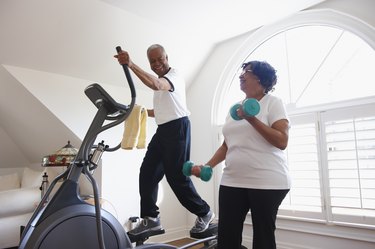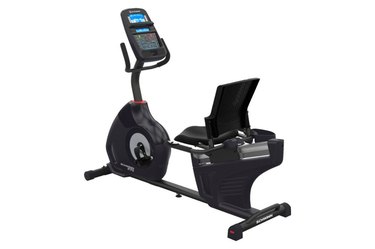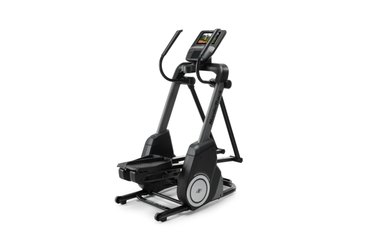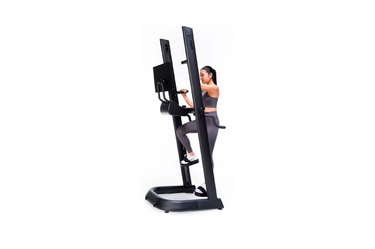
Nothing can throw a wrench into your weight-loss plan like back pain. Whether you're injured or dealing with nagging low back pain (LBP), exercising with the ache can be downright unpleasant.
And yet, exercise is often the best way to manage short- and long-term back pain, says Alina Kennedy, PT, a physical therapist and the founder of The Runners Physio. "Weight loss also plays an important role in improving back pain, so I highly recommend exercise for anyone with back pain," she adds.
Video of the Day
Video of the Day
The key to losing weight when you have back pain is finding the right form of exercise — one that burns calories without making the discomfort worse.
The following home exercise equipment options offer the perfect solution. Each is gentle enough for your sensitive back yet effective enough to aid your weight-loss goal.
Warning
If you’re experiencing back pain, it’s important to get approval from your physical therapist or health care provider before engaging in any form of exercise. Your doctor may even be able to create a personalized exercise program designed to relieve back pain while helping you lose weight.
How We Chose
To bring you the best home exercise equipment, we took recommendations from personal trainers and physical therapists. We also scoured the internet for the highest-rated options, while taking the following criteria into consideration:
- Cost
- Features
- Quality
How We Calculated Calories Burned
We turned to a few expert resources. Harvard Health lists the number of calories burned in 30 minutes for people of three different body weights. We took the estimate for a 155-pound person and multiplied it by two to get calories burned per hour. Because some activities list estimates for different intensity levels, we provided a range. This will tell you how many calories you’ll burn at a lower intensity and how many you’ll burn at a higher intensity.
1. Treadmill
Calories burned per hour: 266 to 350*
*Harvard Health doesn’t provide estimates for treadmill walking specifically, so we used the information listed for walking at a pace of 3.5 miles per hour (mph) and 4 mph.
"Walking is by far the best option for losing weight and managing back pain," Kennedy says.
Walking is not only accessible, but it also helps relieve pain and is less intimidating than other types of exercise in people with chronic low back pain, according to a 2019 review in Disability and Rehabilitation.
You can always walk outside, but a treadmill makes walking accessible any time of year. Plus, you can hold onto the handrails to help you stabilize your torso while walking if you need to, says Katelyn Barrons, CPT, a NASM-certified personal trainer who works with weight-loss clients.
"For best results, try to engage your core while walking by holding a little tension in your stomach, as if bracing for a punch," she says.
Shop These Treadmills
- Echelon Stride Auto-Fold Connected Treadmill ($1,299.99, Echelon)
- Sunny Health and Fitness Foldable Walking Compact Treadmill ($399.99, Sunny Health and Fitness)
- NordicTrack Commercial 1750 ($1,899, NordicTrack)
2. Elliptical
Calories burned per hour: 648
The elliptical machine is another of Kennedy's top recommendations. "It's a low-impact option that won't aggravate back pain and will assist in weight loss," she says.
The activity calls for gliding from one foot to the other, but your feet never actually leave the pedals. It also involves little twisting, turning or pressure on the spine, making it a gentle-but-effective way to burn calories.
To increase your calorie burn, Kennedy suggests pumping the handles with your arms as you go along. You can also bump up the resistance and/or incline.
Shop These Ellipticals
- NordicTrack FreeStride Trainer Series FS10i ($1,799, NordicTrack)
- ProForm Hybrid Trainer XT ($599, ProForm)
- Sunny Health and Fitness SF-E902 Air Walk Trainer ($99.99, Amazon)
3. Vertical Climber
Calories burned per hour: 600 to 1,600
Vertical climbers are exercise machines that mimic the movement of climbing a steep incline. It's an activity that combines cardio with total-body strength training, while placing minimal impact on the joints, according to the Cleveland Clinic.
"It's an upright activity, which is great for sore backs," Kennedy says. Vertical movements get your spine out of that rounded position typical of prolonged sitting.
Vertical climbing also requires you to move both your arms and your legs, which means your spine is getting gentle, healthy movement throughout the workout, Kennedy adds.
Climbing also burns a good amount of calories: The Cleveland Clinic estimates between 600 and 1,600 calories per hour.
Shop These Vertical Climbers
- VersaClimber ($2,295-$2,395, VersaClimber)
- MaxiClimber XL ($399, MaxiClimber)
- CLMBR Connected ($2,495-$3,095, CLMBR)
4. Recumbent Bike

Calories burned per hour: 504 to 556*
*Harvard Health doesn’t provide estimates for a recumbent bike specifically, so we used the information listed for a stationary bike (both moderate and vigorous pace).
A recumbent bike can be a good option for back pain. "It allows you to sit back on an incline, which is usually more comfortable than sitting upright," Kennedy says.
The downside of a recumbent bike? You probably won't burn as many calories as you would walking or on an elliptical, so it's less effective for people wanting to lose weight, Kennedy says.
To burn more calories on the recumbent bike, Barrons suggests doing intervals. Try cycling at a quick pace for 1 minute and then dialing it back for 1 minute. Keep alternating for 10 to 30 minutes.
"You can even work on engaging your core while riding by pressing your spine against the back support pad," Barrons says.
Shop These Recumbent Bikes
- NordicTrack Commercial R35 ($1,499, NordicTrack)
- Schwinn 270 Recumbent Bike ($649, Schwinn Fitness)
- Pro-Form 440 ES ($699, Pro-Form)
Exercise Machines to Avoid
1. Indoor Rower
Any machine that forces you to sit with your spine in a forward-bent position will likely aggravate your back, Kennedy says. An indoor rower is a prime example of just such a machine.
2. Upright Stationary Bike
Like rowing, cycling on an upright stationary bike sticks your spine in an uncomfortable position. "Spines like movement, so any machine that requires your spine to stay still, especially in a forward-bent position, won't be comfortable," Kennedy says.
How to Choose the Best Machine for You
1. Comfort
Ideally, you'll try the exercise machine before buying it, Barrons says. Sample it in the store or at the gym and note how your back feels while using it. If you can, it's also a good idea to have a personal trainer check your form on the machine, to make sure you're using it correctly.
In general, if your pain worsens while using it, it's not the machine for you.
Tip
Make sure to engage your core while using any of these machines. Holding your core in tight to your spine can help prevent lower back pain during exercise.
2. Space
Identify where you plan to set up the exercise machine in your home. Measure the vertical and horizontal dimensions and compare them to the dimensions of the machine you're thinking of buying.
The amount of free space you have may affect which machine you choose. "In general, recumbent bikes will take up less space than treadmills or ellipticals," Barrons says.
Lighter, folding models that are easier to move and store can also be a great option if you don't have a ton of room or haven't picked out a spot yet.
3. Cost
The cost of the exercise machine is one thing to consider when shopping around. However, many machines come with additional costs. Some require a subscription for streaming personal training and group fitness classes. "Make sure to factor group exercise subscriptions into the total cost of the exercise machine," Barrons says.


